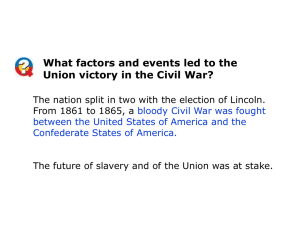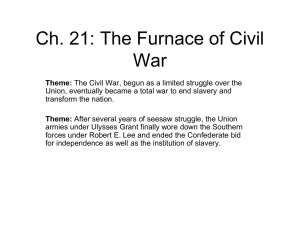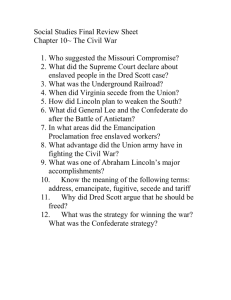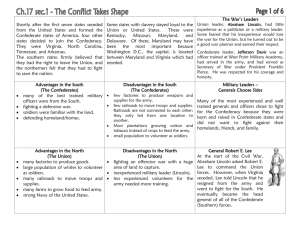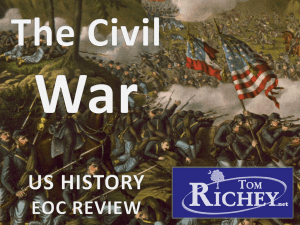Civil War Study Guide
advertisement
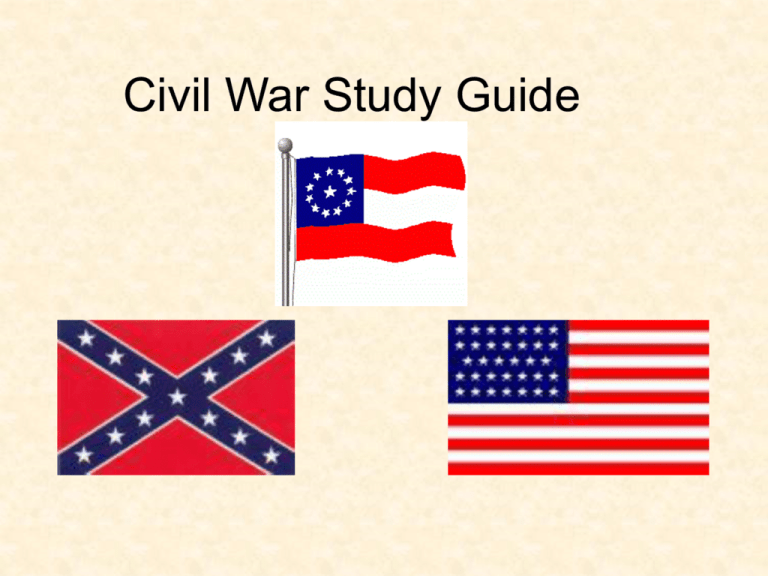
Civil War Study Guide Lincoln Takes Office • Seven states had already seceded and formed Confederate States of America • Lincoln told others that he would not abolish slavery • Confederacy began taking over all federal posts and forts • Fort Sumter – Charleston, SC • April 12, 1861 • First shots of the Civil War • Lincoln calls for 75,000 state militia to put down the rebellion Fort Sumter After The Battle Fort Sumter Today Choosing Sides • Four more slave states join Confederacy – NC, VA, TN, ARK – Richmond, VA. becomes Confederate capital • Slave States that stay with the Union – MD, KY, MO, DE – border states • People of Western Virginia refuse to leave the Union and break away, forming West Virginia into a state by 1863 • Both sides rely on volunteers at the start, believing the war will be over quickly Northern Advantages • North – Union or Federal - Blue • Bigger Population • 22 million to 9.5 million (South) – 4 million slaves • Military-age men • North – 2.1 million • South – 800,000 • Most of the industries, factories, and shipyards – more weapons and supplies • Most of the Railroads • 23,000 miles to 9,000 miles • More efficient transportation • Much bigger financial resources • Central Government is stronger and in charge Southern Advantages • South –Confederate States of America; Confederate or Rebels - Gray • Better military leaders • Southern Lifestyle – southern men were used to being outdoors camping, hunting, riding etc. Made better soldiers at first • Only had to fight defensively – defense has the advantage • Fighting on their own ground First Plans • North • Anaconda Strategy • Blockade southern ports to cut off supplies and control Mississippi River to split South in half • Would not work quickly • Capture Richmond, VA – Confederate Capital • South • Defend itself and wear down North’s will to fight • Capture Washington, DC – Union Capital • Cotton Diplomacy – believed that England and France would help them to get Southern cotton Civil War Weapons • Infantry – foot soldiers – occupy land • Cavalry – rode horses – scouting • Artillery – cannon – support attack and defend places • Battle line – double line of soldiers – one line firing, one line re-loading • Bayonet – stabbing blade attached to end of rifle when charging Springfield – Main Union Rifle Enfield – Main Confederate Rifle Sharps Rifles Spencer Rifle Minie Bullets Napoleon Dahlgren Parrott Canister 13 inch mortars Civil War Battles • South – named battles after nearest town • North – named battles after nearest land feature – town, river, mountain etc. First Battles in the East 1861-62 • Most Major fighting was done in Northern Virginia area between the capitals. • July 21, 1861 – First Bull Run – Confederate Victory – Stonewall Jackson • Both sides prepare for a longer war • North – Army of the Potomac – George McClellan becomes new commander in July 1861 • South – Army of Northern Virginia – Robert E. Lee becomes commander in June 1862 East in 1861-62 continued Robert E. Lee George B. McClellan Stonewall Jackson Eastern Maps for 1861-1862 East in 1861-62 continued • June 26-July 2, 1862 – Seven Days Battles – Confederate Victory • McClellan replaced by John Pope • August 29, 1862 – Second Bull Run – Confederate Victory • McClellan brought back as commander Antietam – September 17, 1862 • Key battle of the war – South hoped that beating North in Maryland would bring in England and France on their side. • Lost Orders – McClellan finds a copy of Lee’s battle plan • Bloodiest single day of the war • Casualties – Union – 12,000 • Confederacy – 13,000 • Basically a draw, but long-term is a Union Victory Emancipation Proclamation • Lincoln felt that freeing slaves in Confederacy would give the North moral superiority • Many northerners did not support this – They wanted to restore the Union, not end slavery • Was it constitutional? • What would the border states do? (KY, MO, DE, MD) • Had to wait for a Union Victory to issue it – Antietam • September 22, 1862 – would take effect on January 1, 1863 • Caused many slaves to attempt to escape whenever Union troops were nearby Battlefield View Confederate dead Bloody Lane Bloody Lane Fredericksburg • McClellan replaced by Ambrose Burnside as Union Commander • December 13, 1862 Worst Union defeat of the war • Casualties • Union – 13,000 • Confederate – 4,500 Ambrose Burnside Union Blockade • North had many more ships and cut off Southern ports, stopping supplies from Europe • Blockade runners • Ironclads • March 9, 1862 – Monitor vs. Virginia (Merrimac) • Last Confederate port open – Wilmington, NC – protected by Fort Fisher – captured by North on January 15, 1865 Monitor after battle with Virginia War in the West • Union Strategy –control the Mississippi • Ulysses S. Grant – Union commander in the west • Shiloh – April 6-7, 1862 – Union victory • By 1863, Union controls all of Mississippi River except for Vicksburg Vicksburg • Key battle in the West • May 22, 1863 – July 4, 1863 • Union Commander – Grant, assisted by William T. Sherman • Confederate Commander – John C. Pemberton • Union Victory – South is split in half Gettysburg • July 1-3, 1863 – Lee hoped that winning a battle in the North would cause the Union to give up and gain the South European assistance • Day One – Culp’s Hill, Cemetery Hill • Day Two – Little Round Top • Day Three – Pickett’s Charge • Casualties • Union – 23,000 • Confederate – 28,000 • South Is on the defensive for the rest of the war • Gettysburg Address – Nov. 19, 1863 Day One Day Two Day Three Little Round Top Dead Union Soldiers in the Wheatfield Dead Union Soldiers in front of Cemetery Ridge Devil’s Den Black Soldiers • Large casualties led some northerners to look at black men as a new manpower source • 1863 – blacks could join the army to fight • 54th Massachusetts Regiment – Fort Wagner – July 18, 1863 – (Glory) • 180,000 blacks served with the Union army War Opposition • Emancipation upset many Northerners • Copperheads – anti-war Democrats • Lincoln dealt with opposition by suspending “Habeas Corpus” – constitutional protection from unlawful imprisonment • 1863 – passed a military draft – caused riots in several cities – New York • South – Prices shot up as blockade cut off supplies – not enough of anything • Confederate money was worthless • Food riots • Draft law of 1862 – large slave owners were exempt; “rich man’s war poor man’s fight” • States did not cooperate – each looked out for its own interests first Home Front • Many men off at war – women had to fill in the jobs – factories, farms etc. • Women had important roles as nurses – Dorothea Dix, Clara Barton, Sally Tompkins • Army camp life was hard • Prison camps were extremely bad – Andersonville • Twice as many soldiers die of disease than in combat • Medical care is poor – didn’t know how to treat infections Union Camp Confederate Camp Union Doctor Performing An Amputation Civil War amputations Gangrene Union Prisoners Getting Food at Andersonville Union Army Cooks Preparing Dinner War in the East 1863-65 • • • • Chancellorsville – April 30 – May 6 1863 Considered to be Lee’s greatest victory Stonewall Jackson killed by his own men Joe Hooker – Union Commander Other Battles • • • • Ulysses Grant becomes main Union commander The Wilderness – May 5-7, 1864 Cold Harbor – June 1-3, 1864 Siege of Petersburg – June 9, 1864-April 2, 1865 • Grant was willing to take huge losses to finish off Lee • May – December 1864 – Sherman’s March to the Sea – William T. Sherman- Atlanta to Savannah; Total Warfare. Casualties in the Civil War • • • • • • • • Shiloh 1862 2nd Manassas 1862 Antietam 1862 Fredricksburg 1863 Chancellorville 1863 Gettysburg 1863 Chickamauga 1863 Wilderness 1864 23,741 23,659 22,720 24,645 30,099 51,112 34,624 25,416 End of the War • Lee attempts to retreat and join other Confederates in NC, but is caught and surrounded by Grant • Appomattox Court House – April 9, 1865 – Lee surrenders his army • April 14, 1865 – Lincoln is assassinated by John Wilkes Booth – southern sympathizer • Remaining Confederate forces surrender by end of May 1865 • War Deaths • Union – 360,000 • Confederacy – 258,000 American Wars • • • • • • • • • • Revolutionary War 1775-1783 4,435 War of 1812 1812-1815 2,260 Mexican War 1846-1848 13,283 Civil War 1861-1865 623,026 Spanish-American 1898 2,446 WWI 1917-1918 116,708 WWII 1941-1945 407,316 Korean War 1950-1953 36,914 Vietnam War 1964-1973 58,169 Persian Gulf War 1991 269 Lincoln/Kennedy assassination • • • • Abraham Lincoln was elected to Congress in 1846. John F. Kennedy was elected to Congress in 1946. Abraham Lincoln was elected President in 1860. John F. Kennedy was elected President in 1960. The names Lincoln and Kennedy each contain seven letters. Both were particularly concerned with civil rights. Both wives lost their children while living in the White House. Both Presidents were shot on a Friday. Both were shot in the head. Here is an interesting one... Lincoln's secretary was named Kennedy. Kennedy's secretary was named Lincoln. • • Both were assassinated by Southerners. Both were succeeded by Southerners. Both successors were named Johnson. Andrew Johnson, who succeeded Lincoln, was born in 1808. Lyndon Johnson, who succeeded Kennedy, was born in 1908. John Wilkes Booth, who assassinated Lincoln was born in 1839. Lee Harvey Oswald, who assassinated Kennedy was born in 1939. Both assassins were known by their three names. Both names compromise fifteen letters. Booth ran from the theater and was caught in a warehouse. Oswald ran from a warehouse and was caught in a theater.
